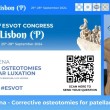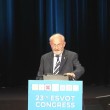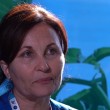Jan Eric Raiha
DVM PhD National specialist in Small Animal Medicine
G.S-S. Why did you decide to become a veterinarian and did orthopaedics particularly interest you prior to your clinical years in University?
J.R. I was initially accepted to the University. of Technology here in Helsinki and studied there for 4 years before I realized that I want to work with my hands and not be confined to an office environment. I also have a burden of 3 generations of physicians on my shoulders, but not an urge to do human medicine. Of course my thoughts were also influenced by my fiancée, now wife Maija, who always had wanted to become a veterinarian and at that time studied vet med at the Univ.
G.S-S. Once you knew that you wanted to specialise in surgery, had you already decided to go deeper into the subject of orthopaedics and did any particular teacher influence your thoughts and decision?
J.R. At an early stage I knew orthopaedics was my call. This had to do with my desire to work with my hands and that back ground at the Univ. of Technology. In the beginning I did a lot of soft tissue too, but that has diminished. My tutor, Matti Mero, professor at the surgery department at that time, got me into a PhD programme at the human Orthopaedic Hospital under the legendary professor Pentti Rokkanen and that took my into the world of biodegradable implants for fracture fixation.
G.S-S. Please give readers a synopsis of your practice: specialty, staff, colleagues and patients
J.R. Maija and I founded the practice in 1992, when my PhD was finalizing. Within a few years we had several vets and now about 10 with a small satellite practice near by. All our vets have a special interest in a certain part of small animal medicine and the rest of the staff we also consider highly trained. 4 years ago we merged with two other practices to form the “UNIVET”-group, now consisting of 10 practices in southern Finland. Our intention is to grow at a pace of 2-3 practices annually. Evidence based medicine is our guide line and teaching quality medicine is Univet’s mission.
G.S-S. Are there any particular techniques or achievements of which you are particularly proud?
J.R I worked intensely with fixation techniques for polylactic and polyglycolic rods, plates and screws to develop standardised methods to utilise these implants.
Cruciate problems and hip implants have always been a central part of my practice
G.S-S How many veterinarians are there now in UNIVETand are some of them specialists who visit other practices in the group to see special cases. In total, how many clinicians and support staff do you have?
J.R. At the moment Univet consists of about 30 veterinarians and a support staff of about 50-60 technicians, receptionists and administrators. We try to educate the whole group by visiting the various practices within the group, for short or long periods and arranging joint continuing education opportunities, often with invited international speakers. In the group we have several specialist and a few Diplomated veterinarians
















